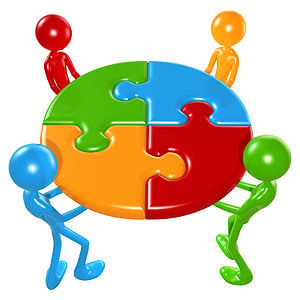Conflict and Collaboration
By Jaco Grobbelaar on Tue, Nov 15, 2011 @ 07:13 PM

Conflict occurs when a team member or even the entire team are not getting what they need or want and seek their own self-interest. Often the individual is not aware that he has a need and acts out unconsciously. Other times, however the individual is very aware of his wants and actively works at achieving the goal.
After the team leader has seen the beginnings of the conflict through looking at conflict indicators and has determined if the conflict is destructive or the leader can turn it around into a constructive conflict and has done what he can to resolve the conflict, That Leader might propose a new way of reaching consensus—that of collaboration.
Conflict is hard to resolve peacefully. Whereas working together using collaboration is a much more productive way to work things out. Groups often collaborate closely in order to reach consensus and agreement.
The use of collaboration requires the recognition of and respect for everyone’s ideas, opinions and suggestions. The primary rule of respect is paramount to the success of this process. Consensus requires that each team member must agree on the point being discussed before it becomes a part of the discussion. Not every point will meet with everyone’s complete approval, but then unanimity is not the goal. The goal is to have the individuals accept a point of view based on logic. When the individual team members can understand and accept the logic of a different point of view, the team leader can see that the team has reached consensus.
When That Leader can draw his team to use collaboration rather than conflict resolution, he will reap the benefit of a team with respect for everyone’s ideas, opinions and suggestions.
Have you seen successful collaboration? Was it what you expected? Did you find it a better method than conflict resolution? Please answer in the comment box below.
This information is from Washington State School Directors’ Association and found on http://www.nsba.org/sbot/toolkit/
After the team leader has seen the beginnings of the conflict through looking at conflict indicators and has determined if the conflict is destructive or the leader can turn it around into a constructive conflict and has done what he can to resolve the conflict, That Leader might propose a new way of reaching consensus—that of collaboration.
Conflict is hard to resolve peacefully. Whereas working together using collaboration is a much more productive way to work things out. Groups often collaborate closely in order to reach consensus and agreement.
The use of collaboration requires the recognition of and respect for everyone’s ideas, opinions and suggestions. The primary rule of respect is paramount to the success of this process. Consensus requires that each team member must agree on the point being discussed before it becomes a part of the discussion. Not every point will meet with everyone’s complete approval, but then unanimity is not the goal. The goal is to have the individuals accept a point of view based on logic. When the individual team members can understand and accept the logic of a different point of view, the team leader can see that the team has reached consensus.
- In order to reach consensus That Leader must keep the group from arguing over individual ranking or position. The person with a particular position needs to present his position as logically as possible.
- That Leader needs to see that there are no “win-lose” statements. All must discard the idea that someone must win.
- Team members need to learn to speak with integrity so that there won’t be members changing their mind to avoid conflict and achieve harmony.
- There should not be any majority voting, averaging, bargaining or coin flipping. These don’t lead to consensus. All differences of opinion indicate that there is still an incomplete sharing of relevant information. That Leader needs to keep the team asking questions.
- That Leader also needs to project the attitude that holding different views is both natural and healthy to the team.
- She must also view any initial agreement as suspect and help the team explore underlying apparent agreement and make sure that members have agreed willingly.
When That Leader can draw his team to use collaboration rather than conflict resolution, he will reap the benefit of a team with respect for everyone’s ideas, opinions and suggestions.
Have you seen successful collaboration? Was it what you expected? Did you find it a better method than conflict resolution? Please answer in the comment box below.
This information is from Washington State School Directors’ Association and found on http://www.nsba.org/sbot/toolkit/
Jaco Grobbelaar, owner of BroadVision Marketing, helps business owners and business professionals put marketing strategies in place that consistently secure new clients. He can be reached at jaco@broadvisionmarketing.com or 707.799.1238. You can “Like” him at www.facebook.com/broadvisionmarketing or connect with him on www.linkedin.com/in/JacoGrobbelaar.
Related articles
- Collaboration and Effective Team Building (drsuneelsethi.wordpress.com)
- How to build a cohesive team (wiki.answers.com)
Share this
You May Also Like
These Related Stories
Team Leadership Accountability


Team Leadership Accountability
Thu, Oct 20, 2011 @ 08:13 PM
2
min read
9 Possible Causes of Conflict


9 Possible Causes of Conflict
Sun, Nov 13, 2011 @ 05:15 PM
4
min read
That Leaders Communication Tools


That Leaders Communication Tools
Sun, Oct 30, 2011 @ 08:17 PM
3
min read
.png?width=302&height=75&name=BVM%20Logo%20-%20transparent%20(1).png)

No Comments Yet
Let us know what you think